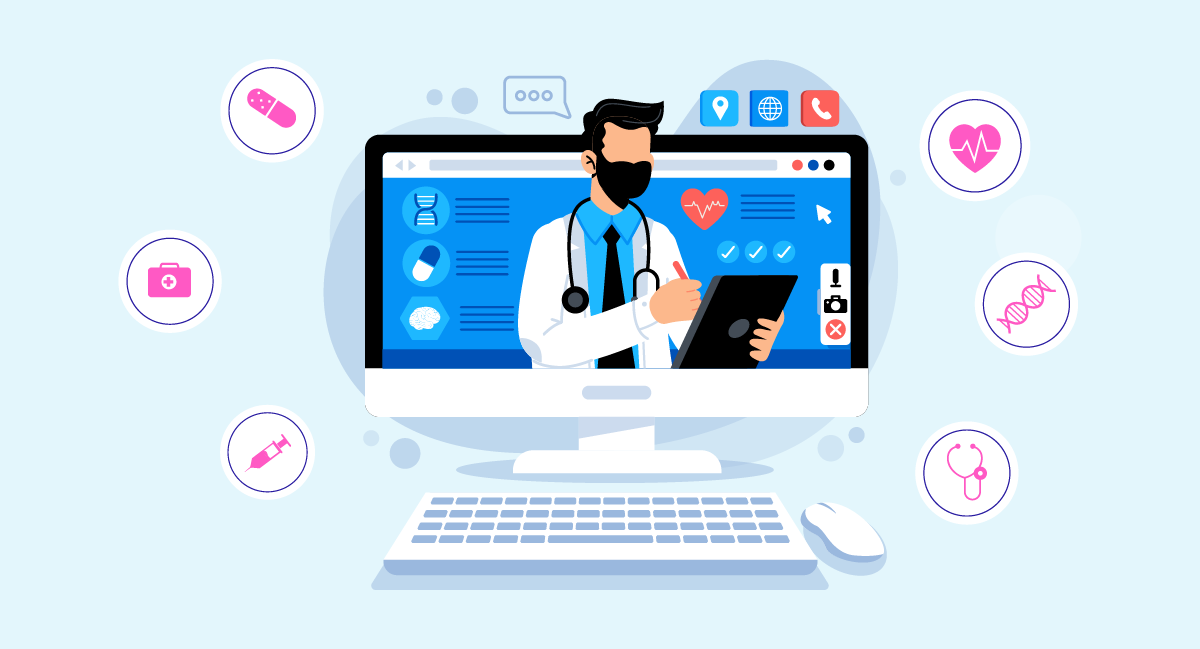
Learn how to build comprehensive hospital management software that enhances efficiency through automation, improving patient care and operational effectiveness.
In an era where efficiency and patient satisfaction are paramount, hospital management software (HMS) plays a transformative role in modern healthcare. By automating processes like patient registration, billing, and medical records management, this technology streamlines operations and enhances the healthcare experience for all stakeholders. Here’s a breakdown of what it takes to understand how to build a hospital management system and create effective hospital management software.
What is Hospital Management Software?
Hospital management software is a digital ecosystem designed to manage patient information and automate critical administrative and medical processes. Its stakeholders include:
- Patients: Scheduling appointments, accessing records, managing billing, and requesting prescriptions.
- Medical Staff: Documenting patient care, prescribing medications, and accessing real-time data.
- Administrators: Overseeing operations, resource allocation, and strategic planning.
- Finance Teams and Insurers: Streamlining billing, financial reporting, and insurance verification.
- Regulatory Authorities: Ensuring compliance with healthcare standards.
By focusing on how to build a hospital management system that addresses these needs, organizations can ensure seamless integration, enhanced security, and improved outcomes for all users.
Emerging Trends in Healthcare Technology
1. AR and VR in Medicine
Augmented and virtual reality are revolutionizing patient preparation for procedures and enhancing clinical performance. Proper implementation minimizes human errors, offering a safer healthcare environment. Partnering with specialized agencies can help integrate AR and VR into hospital systems effectively.
2. Cybersecurity Measures
As healthcare becomes increasingly digital, it faces heightened cybersecurity threats. In 2024, data breach costs in the U.S. healthcare sector reached an average of $11 million. Multi-factor authentication, endpoint encryption, and strict access controls are essential in mitigating these risks.
3. Artificial Intelligence (AI)
AI enhances diagnostics, identifies health trends, and predicts patient outcomes. It reduces administrative errors, automates processes like insurance fraud detection, and facilitates personalized care plans.
4. Internet of Medical Things (IoMT)
IoMT improves remote patient monitoring, reduces costs, and elevates patient satisfaction by connecting medical devices and healthcare systems seamlessly.
5. Big Data Analytics
Big data enables advanced diagnostics, risk analysis, and tailored treatment plans. Hospitals leverage this technology to improve therapy outcomes and operational efficiency.
6. Blockchain for Data Security
Blockchain ensures transparency and secures sensitive patient data. Major tech players like Google and Microsoft are heavily investing in this area, with the market projected to grow at a 76.30% CAGR, reaching $7.3 billion by 2028.
7. Cloud Transformation
Cloud-based solutions offer real-time data access and streamline operations across healthcare systems, from small clinics to large hospitals.
Key Features of a Custom Hospital Management System
Patient Portal and Appointment Scheduling
A patient portal allows users to access records, view test results, and communicate with providers. Online appointment scheduling improves accessibility and reduces administrative burdens.
Electronic Medical Records (EMR) and Medication Refills
Comprehensive EMRs provide a detailed health history, while automated refill functions simplify medication management for patients.
Efficient Billing
Clear and concise billing systems aid patients in managing healthcare expenses while improving financial transparency.
Telehealth Services
Virtual consultations eliminate logistical challenges, expanding access to care and reducing overhead costs.
Automated Notifications and Registration Systems
Scheduled messages remind patients of upcoming appointments, while digital check-in systems streamline administrative workflows.
Feedback Mechanisms
Patient reviews drive service improvements, helping healthcare facilities identify areas for refinement while boosting their reputation.
Privacy and Security Features
Adherence to legal standards ensures that patient data is protected, fostering trust and compliance with privacy regulations.
Virtual Waiting Rooms
A virtual waiting room enhances patient satisfaction by reducing physical waiting times and minimizing exposure to contagious diseases.
Key Benefits of Hospital Management Systems
1. Resource Optimization
Digital record-keeping simplifies data access for medical staff, resulting in faster and more accurate diagnoses, treatment plans, and prescriptions.
2. Error Reduction
Automation minimizes human intervention, significantly reducing the likelihood of errors in medical and administrative processes.
3. Data Security
Clinic management software complies with regulations like HIPAA (USA) and PIPEDA (Canada), ensuring that patient data remains secure. Access is restricted to authorized users with assigned credentials, safeguarding sensitive information.
4. Cost Efficiency
By automating repetitive tasks, this software reduces the need for additional staff, cutting costs and alleviating employee burnout.
5. Enhanced Patient Experience
Patients benefit from online appointment scheduling, streamlined consent form processes, and more personalized care as staff are freed from administrative burdens.
Types of Hospital Management Software
1. Electronic Health Record (EHR) Systems
Consolidates patient information, including medical history, prescriptions, and treatment plans.
- EPR Software: Specializes in storing and processing patient data.
- EMR Software: Focuses on medications, treatments, and recovery details.
2. Medical Database Software
Organizes patient information by disease rather than individual profiles, aiding in case study reviews and accurate treatments.
3. Telemedicine Software
Facilitates remote communication between doctors and patients, offering features like e-prescriptions and billing integration.
4. Appointment Scheduling Software
Automates appointment management with notifications, reminders, and patient panel creation.
5. Medical Billing Software
Streamlines financial processes and integrates seamlessly with larger systems like EHRs.
6. Health Tracking Apps
Mobile tools that monitor fitness, diet, and stress levels, often synced with IoT devices for real-time updates.
7. Remote Patient Monitoring (RPM)
Tracks chronic conditions outside clinical settings using connected technologies.
8. mHealth Apps
Combines telemedicine, billing, and appointment scheduling into user-friendly mobile platforms.
Steps to Create Hospital Management Software
1. Conduct Market Research
Understanding user needs is the foundation of successful development. Stakeholder surveys, competitive analysis, and feasibility studies are critical. Identify what existing systems lack and define how your solution will fill those gaps.
2. Choose the Right System Type
Differentiate between administrative, task-based, and subject-focused systems. Each serves unique purposes, from storing patient interactions to coordinating hospital operations.
3. Select Core Features
Focus on features that offer real value:
- Patient Registration: Streamlines onboarding for new patients.
- EHR Management: Tracks medical histories, test results, and treatment plans.
- Appointment Scheduling: Simplifies provider-patient interactions.
- Billing and Insurance Integration: Automates financial tasks.
- Inventory and Pharmacy Management: Tracks supplies and medications.
- Reporting and Analytics: Provides actionable insights for administrators.
4. Prioritize User-Centric Design
A hospital management system must cater to diverse user groups with varying levels of technical expertise. Adopt minimalistic, distraction-free designs that enhance usability without overwhelming users. Consider the institution’s size and specific needs to tailor your software accordingly.
5. Build an MVP (Minimum Viable Product)
Developing a basic version of the software allows you to test feasibility and safety before full-scale deployment. Benefits include:
- Faster Time-to-Market: A working prototype can be launched in six months.
- Cost Savings: Avoid unnecessary features and focus on core functionality.
- Enhanced Feedback Loop: Early users provide valuable insights for refinement.
6. Launch a Fully-Fledged Product
After the MVP proves viable, gather feedback from patients and providers to refine the final product. Use KPIs such as customer acquisition cost, churn rate, and lifetime value to assess the software’s success and identify areas for improvement.
Conclusion
Creating hospital management software requires a blend of market understanding, technological expertise, and user-centered design. By addressing specific healthcare challenges with innovative features and secure solutions, HMS can elevate patient care and streamline operations for medical providers worldwide.
Was this news helpful?







 Yes, great stuff!
Yes, great stuff! I’m not sure
I’m not sure No, doesn’t relate
No, doesn’t relate



